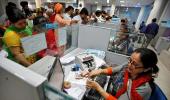Finance Minister Nirmala Sitharaman's Rs 30,600 crore government guarantee for the bad bank has changed the body language of bankers for the better, observes Tamal Bandyopadhyay.

Ever since Finance Minister Nirmala Sitharaman announced a Rs 30,600 crore (Rs 306 billion) government guarantee for the bad bank, the body language of the bankers has changed.
The guarantee will be given for the securities receipts that the bad bank will issue to commercial banks while buying bad loans worth Rs 2 trillion from them.
A recovery of at least Rs 30,600 crore is ensured. It could be even more.
Prospective buyers have already started smelling an opportunity.
Some of them are global entities. This is why bankers are smiling.
How will the bad bank, christened National Asset Reconstruction Company (NARCL), work? Banks of all hues have chipped in with equity but public sector banks have the majority ownership.
The bad bank will buy Rs 2 trillion worth of chronic bad loans from the banking system.
The valuation is pegged at 18 per cent.
This means, banks will get Rs 36,000 crore (Rs 360 billion) from the bad bank, selling a big lump of their bad loans.
NARCL will offer 15 per cent cash to banks and 85 per cent in the form of SRs.
Banks will get Rs 5,400 crore (Rs 54 billion) cash, upfront, roughly the amount they are investing in the bad bank as their equity.
To that extent, it's a cash-neutral transaction for the industry, but not necessarily for each bank.
It will depend on how much bad loans a bank is selling and how much equity it has put in the bad bank.
There is no sunset clause for the bad bank, but the government guarantee will be valid for five years.
The timeframe will push the bad bank to work hard for recovery.
At this point, we don't know whether it will be extinguished after five years, with the expiry of the government guarantee.
The deciding factors will be its performance and the state of affairs in Indian banking.
If another wave of bad loans hits the industry over the next few years, it may remain in existence.
NARCL has already been registered. And the industry has already identified two dozen-odd bad loans worth around Rs 91,000 crore (Rs 910 billion).
The list includes Videocon Oil Ventures Ltd, Reliance Naval and Engineering Ltd, Amtek Auto Ltd, Jaypee Infratech Ltd, Castex Technologies Ltd, GTL Ltd, Visa Steel Ltd and Lavasa Corporation Ltd, among others.
In each case, the banking industry has at least Rs 500 crore (Rs 5 billion) exposure.
The biggest bad loan is that of Videocon Oil Ventures, around Rs 22,500 crore (Rs 225 billion).
The State Bank of India, IDBI Bank Ltd, Punjab National Bank, Union Bank of India and Indian Overseas Bank are the lead lenders for many of these cases.
How is NARCL different from the existing 28 asset reconstruction companies, a few of which are at least one-and-a-half decades old?
It is different in many ways.
NARCL is just one leg of the new prop to tackle bad loans.
The other is the India Debt Reconstruction Company Ltd (IDRCL).
It will act like an asset management company but technically it is a non-banking financial company, regulated by the Reserve Bank of India.
While NARCL is the bad debt aggregator, IDRCL will take care of the resolution of bad assets.
This structure is different from the existing asset reconstruction companies, which do both bad debt aggregation as well as resolution.
At least a few of them focus more on fee income from managing the assets than resolution.
Since public sector banks (which have more bad loans than many of their private peers) will have the majority shareholding of the NARCL, and a ballpark valuation is already arrived at, aggregation of the debt to be sold to the bad bank will not be a problem.
The first tranche is waiting to be sold, while banks are in the process of identifying the second tranche of Rs 1.09 trillion bad debts.
Being majority owned by the private sector, IDRCL will escape the glare of investigative agencies such as the Central Bureau of Investigation, Chief Vigilance Commission and the Directorate of Enforcement.
This will help it resolve bad loans fast without hitches.
Since banks have already provided for such loans, whatever is recovered will add to their profits.
They can earn even more than 18 per cent of the value of such assets once all the cases are resolved.
I don't think any detailed exercise has been undertaken for the price discovery of these assets.
Banks have already plucked the low hanging fruits such as Essar Steel Ltd and Bhushan Steel Ltd, and eaten them.
Most of these accounts being transferred to NARCL are complex in nature.
There are projects in power, road and other segments of infrastructure, which have not been able to service loans because they have not yet started generating cash flows.
Many of them will need an infusion of fresh money.
IDRCL can take care of such needs. An up and running entity can fetch the enterprise value but junk projects cannot.
The success of the bad loan experiment will depend on the management team of IDRCL and the incentive structure for its employees.
If it picks the best talent from the market and is liberal in offering incentives for recovery of loans above 18 per cent, it could generate more than what the industry is estimating now.
Many, however, are saying it's too late.
Some of the projects that will be up for sale have either turned junk or are losing their value.
If at all, the bad bank should have made its appearance earlier.
This may not be a correct assessment.
As we wade through the second wave of the Covid pandemic, consumer demand is picking up.
There will be many takers for the brownfield projects.
It is perfectly timed; there could not have been a better time for the sale of some of these projects.
Along with banks, which will be able to realise the enterprise value of many such exposures, the real economy will also benefit from this.
And, if IDRCL is able to attract murky alternative investment funds as buyers, the secondary market for SRs will develop, which will give a big boost to the bad loan recovery process in the future.
The insolvency law has been slow in the recovery of bad loans for multiple reasons.
In the process, the value of many projects gets destroyed and what the banks earn is close to their liquidation value, far lower than their enterprise value.
The big, fat bad bank can recover more if the project is executed well by a professional and empowered management.
Tamal Bandyopadhyay, a consulting editor with Business Standard, is an author and senior adviser to Jana Small Finance Bank Ltd.
Feature Presentation: Aslam Hunani/Rediff.com











